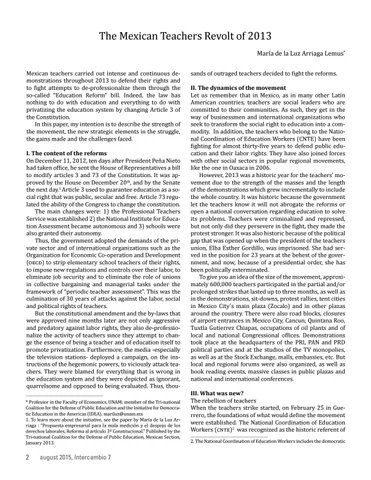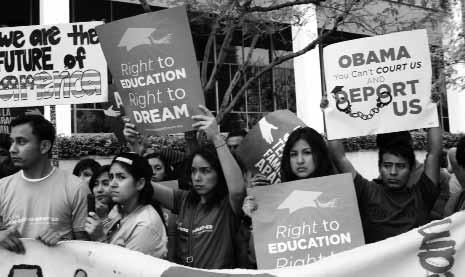The Mexican Teachers Revolt of 2013 Mexican teachers carried out intense and continuous demonstrations throughout 2013 to defend their rights and to fight attempts to de-professionalize them through the so-called “Education Reform” bill. Indeed, the law has nothing to do with education and everything to do with privatizing the education system by changing Article 3 of the Constitution. In this paper, my intention is to describe the strength of the movement, the new strategic elements in the struggle, the gains made and the challenges faced.
I. The content of the reforms On December 11, 2012, ten days after President Peña Nieto had taken office, he sent the House of Representatives a bill to modify articles 3 and 73 of the Constitution. It was approved by the House on December 20th, and by the Senate the next day.1 Article 3 used to guarantee education as a social right that was public, secular and free. Article 73 regulated the ability of the Congress to change the constitution. The main changes were: 1) the Professional Teachers Service was established 2) the National Institute for Education Assessment became autonomous and 3) schools were also granted their autonomy. Thus, the government adopted the demands of the private sector and of international organizations such as the Organization for Economic Co-operation and Development (oecd) to strip elementary school teachers of their rights, to impose new regulations and controls over their labor, to eliminate job security and to eliminate the role of unions in collective bargaining and managerial tasks under the framework of “periodic teacher assessment”. This was the culmination of 30 years of attacks against the labor, social and political rights of teachers. But the constitutional amendment and the by-laws that were approved nine months later are not only aggressive and predatory against labor rights, they also de-professionalize the activity of teachers since they attempt to change the essence of being a teacher and of education itself to promote privatization. Furthermore, the media -especially the television stations- deployed a campaign, on the instructions of the hegemonic powers, to viciously attack teachers. They were blamed for everything that is wrong in the education system and they were depicted as ignorant, quarrelsome and opposed to being evaluated. Thus, thou-
* Professor in the Faculty of Economics, UNAM; member of the Tri-national Coalition for the Defense of Public Education and the Initiative for Democratic Education in the Americas (IDEA). mariluz@unam.mx 1. To learn more about the initiative, see the paper by María de la Luz Arriaga : “Propuesta empresarial para la mala medición y el despojo de los derechos laborales, Reforma al artículo 3º Constitucional.” Published by the Tri-national Coalition for the Defense of Public Education, Mexican Section, January 2013.
2
august 2015, Intercambio 7
María de la Luz Arriaga Lemus*
sands of outraged teachers decided to fight the reforms.
II. The dynamics of the movement Let us remember that in Mexico, as in many other Latin American countries, teachers are social leaders who are committed to their communities. As such, they get in the way of businessmen and international organizations who seek to transform the social right to education into a commodity. In addition, the teachers who belong to the National Coordination of Education Workers (CNTE) have been fighting for almost thirty-five years to defend public education and their labor rights. They have also joined forces with other social sectors in popular regional movements, like the one in Oaxaca in 2006. However, 2013 was a historic year for the teachers’ movement due to the strength of the masses and the length of the demonstrations which grew incrementally to include the whole country. It was historic because the government let the teachers know it will not abrogate the reforms or open a national conversation regarding education to solve its problems. Teachers were criminalized and repressed, but not only did they persevere in the fight, they made the protest stronger. It was also historic because of the political gap that was opened up when the president of the teachers union, Elba Esther Gordillo, was imprisoned. She had served in the position for 23 years at the behest of the government, and now, because of a presidential order, she has been politically exterminated. To give you an idea of the size of the movement, approximately 600,000 teachers participated in the partial and/or prolonged strikes that lasted up to three months, as well as in the demonstrations, sit-downs, protest rallies, tent cities in Mexico City´s main plaza (Zocalo) and in other plazas around the country. There were also road blocks, closures of airport entrances in Mexico City, Cancun, Quintana Roo, Tuxtla Gutierrez Chiapas, occupations of oil plants and of local and national Congressional offices. Demonstrations took place at the headquarters of the PRI, PAN and PRD political parties and at the studios of the TV monopolies, as well as at the Stock Exchange, malls, embassies, etc. But local and regional forums were also organized, as well as book reading events, massive classes in public plazas and national and international conferences.
III. What was new? The rebellion of teachers When the teachers strike started, on February 25 in Guerrero, the foundations of what would define the movement were established. The National Coordination of Education Workers (cnte)2 was recognized as the historic referent of 2. The National Coordination of Education Workers includes the democratic










